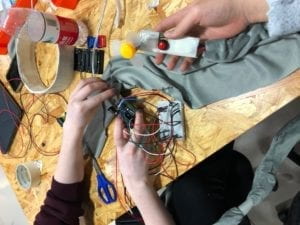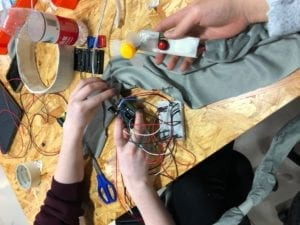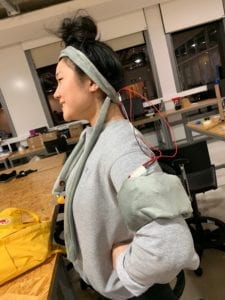For our project, my partner and I struggled with coming up with a struggle we both encounter enough to seek a solution for, so we turned to resolve a problem most other people face, sweating uncontrollably while working out. We thought it was amusing we would try to do such a thing but thinking about it we realized that we could build our activewear to do what we would want our activewear to do. So we decided on creating a headband that would hold hair back, absorb sweat, and give us the option to fan ourselves, if needed, and paired it with an armband that has space to securely hold a phone. The special aspect of our headband was that it incorporates the use of a temperature sensor within the headband to monitor body heat and activate fan usage. If the user reaches a high enough temperature then they could use the fan as they please but if they do not reach the needed temperature then the fan would not turn on at the push of the button. We used a temperature sensor instead of a moisture sensor because not everyone sweats so our activewear is good for anyone who works out and wants to stay cool while looking cool.
It was suggested during the user testing that we combined the temperature sensor portion of the setup with the breadboard and Arduino and form it into a sort of hat instead of a headband, but due to time constraints we were not able to test out the suggestion but I think that that extra weight on the head is a nuisance when working out so specifically for this project I do not think that a weighted hat would feel great but it might have been more aesthetically pleasing. During user testing, we were asked why would we incorporate a temperature sensor into activewear, wouldn’t the user know whether or not if they are hot and can turn on a fan themselves. I think yes a user could just turn on a fan if they were feeling warm but I think our design gives the user more control over their fan because it interacts with their body and provides access to the fan when it senses that you need it the most. This way if the user is to wear the headband as part of their athleisure outfit they cannot be distracted by the attached fan, whereas and small portable fan could be a fun toy when procrastinating.

Our final design consists of a matching set of a headband and armband. It is made of a soft, gray fabric that is handsewn which ensures proper and comfortable placement of the wires throughout the headband and armband. The headband has the temperature sensor neatly tucked away in the fabric so that it laid comfortably on the user’s temple and then through one of the long strands that hangs down the fan was safe inside the fabric. The placement of the fan, along with its button, is conveniently put to hang down the user’s front side so that it is easy to reach. We made the armband adjustable by using a 3D printed clip using files from thingiverse.com. My partner and I encountered a huge problem with printing the clip and ended up attempting to print the female half of the clip for than 8 times and only with the help of a fellow and a different file clip from the original version did we print a decent female clip. Each clip seemed to be printing too thin and broke as soon as we clipped the two pieces together. We were told that our set is comfortable to wear but may be a little too thick and may promote sweating rather than preventing it. In the future, if we were to update this project we will most likely change the fabric material and try to make the wires more hidden someway.

A huge problem we ran into was the code. It worked well at first and was very long and complicated as we tried to combine the motor fan set up and a temperature sensor set up we learned in class. This worked at first but then stopped working when we started trying to fit it into the fabric. we solved this by completely redoing the code to the one shown below with the help of a fellow.
Ultimately, my partner and I achieved the activewear we were attempting to create. The headband only works through interaction with it and we received fairly positive constructive criticism. Users understood our concept, was a little confused with our execution during user testing but interacted with it properly. Without too much explanation, users understood that it consisted of a headband and an armband, but the wires made how to put it on a little confusing. In the future, we would attempt to make this device wireless to reduce confusion and give the user more freedom to move and decide how to wear it. This project has taught me that 3D printers are really finicky and will work sometimes. User testing is really important for projects like these because it helps you weed out flaws you might have overlooked. For example, as the creator, I know what I am building or creating so when a user cannot tell how to interact with what I made makes me realize that I have to simplify and modify it so it is easier to digest.

Code:
int pushButton = 2;
// give a name to digital pin 2, which has a pushbutton attached
int motorControl = 9;
// the transistor which controls the motor will be attached to digital pin 9
int tempPin = A0;
// sets the pin for the temp sensor
//int ledPin = 13;
boolean oldSwitchState = LOW;
boolean newSwitchState1 = LOW;
boolean newSwitchState2 = LOW;
boolean newSwitchState3 = LOW;
boolean LEDstatus = LOW;
void setup() {
pinMode(pushButton, INPUT);
// make the pushbutton’s pin an input
pinMode(motorControl, OUTPUT);
// make the transistor’s pin an output
pinMode(tempPin, INPUT);
//make the temp sensor an input
//pinMode(ledPin, OUTPUT);
digitalWrite(motorControl, 0);
Serial.begin(9600);
}
void loop() {
int temp = analogRead(tempPin);
newSwitchState1 = digitalRead(pushButton);
// delay(1);
// newSwitchState2 = digitalRead(pushButton);
// delay(1);
// newSwitchState3 = digitalRead(pushButton);
Serial.println(newSwitchState1);
//if(temp >= 45){
if (newSwitchState1 == 1) {
analogWrite(motorControl, 0);
Serial.println(“motor on”);
// pass currenr through fan
} else {
analogWrite(motorControl, 255);
Serial.println(“motor off”);
}
}
Citations:
Female clip:
https://www.thingiverse.com/thing:3415522
Male clip:
https://www.thingiverse.com/thing:2591485